Metro X Board Game Review
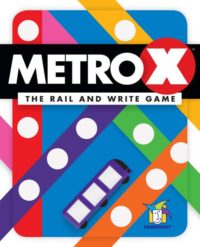
Years ago, when my wife and I took our long-anticipated trip to London, we were super excited to see so many sites. But we knew the first step to seeing them would be getting there!
So we headed to the Underground and pleasantly discovered the wonderful world of the Tube.
And now when we play Metro X, we can’t help but recall our fantastic week in London.
That’s because the Metro X board game is all about navigating your subway map in optimal fashion!
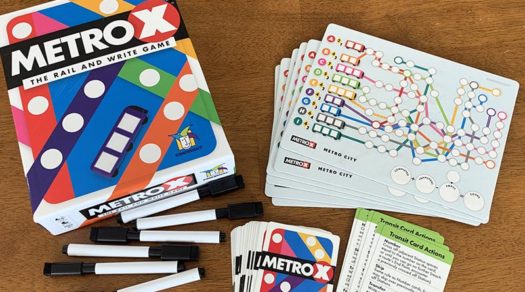
How to play Metro X
The goal of Metro X is to be the player with the most points from completed routes and transfers.
To begin, each player takes a Metro map dry-erase board and a marker. Players decide which side of the board they want to play on. Then one player shuffles the deck of cards and they’re ready to play!
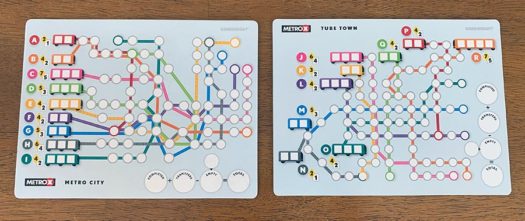
The subway maps have Train Cars and Stops. On each flip of the card, players fill in Train Car windows and Stations on that Train Car’s route.
One player flips over the top card of the deck and then everyone simultaneously marks spaces on their board. How spaces are marked depends on which type of card is drawn.
There are 4 different types of cards and each are listed on the reference cards included in the game.
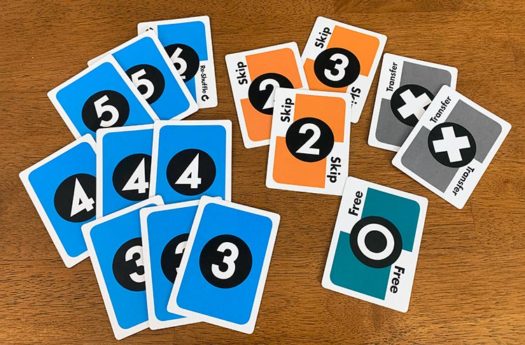
Number: Fill in any empty Train Car window with the number on the card. Then on that route, find the first empty station from the start point and place an X in it. Continue crossing out adjacent stations on that route either up to the number on the card or until the next station already has an X in it. Since lines cross paths and share stations, players may not be able to use the full number from the card.
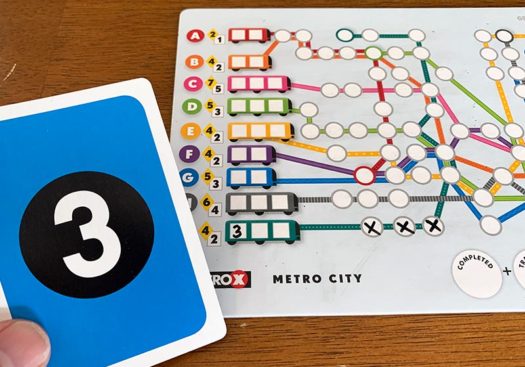
Skip: These are like Number cards (fill in Train Car window with the number, etc) but they allow players to skip over stations on the route that are already crossed off.
Transfer: Fill in an empty Train Car window with an X. Then, on that route, find the first empty station from the start point and fill it with a number equal to twice the number of routes that make a stop there. For example, if there are 3 routes connecting through the station, players would write a “6” in the station.
Free: Cross off any station of your choice and don’t place anything in a Train Car window.
When a player crosses off all stations along a route, they announce their completion and circle the Points awarded for that route. If they are the first player to complete that route, they circle the number in the Yellow diamond next to the Train Car. If they aren’t the first, they circle the number in the White box.
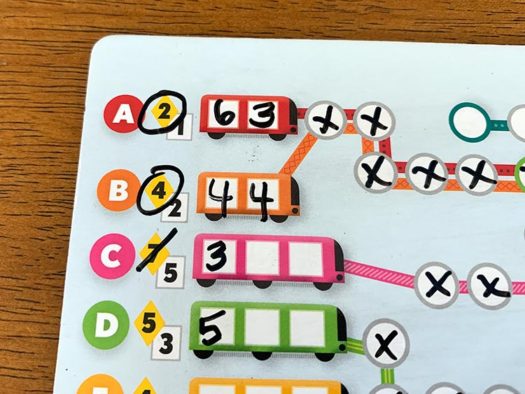
The game ends when all Train Car windows are filled in. Since the game is played simultaneously, every player will finish at the same time.
Then players add up their points.
Players first total their points from completed routes. Then they add the values from all their Transfer locations (the stations where they wrote in numbers). And then they subtract points based on the number of stations left empty on their board (the reference cards indicate how many points are subtracted based for this).
Then they total up all their scores and the player with the highest score wins!
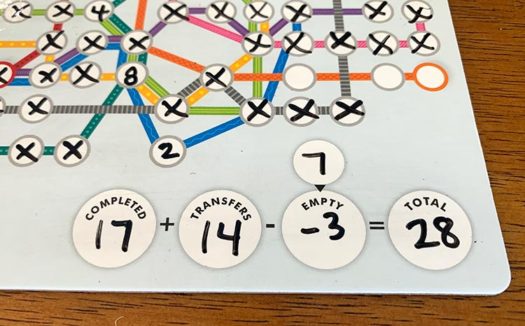
Can the whole family enjoy Metro X?
Like almost every Gamewright game we’ve reviewed, Metro X is a great game for everyone in the family to enjoy playing together!
As you can see, the rules to the game are very simple and straightforward. The tricky part all lies in how players choose to fill our their maps.
And it feels like a fun puzzle every time!
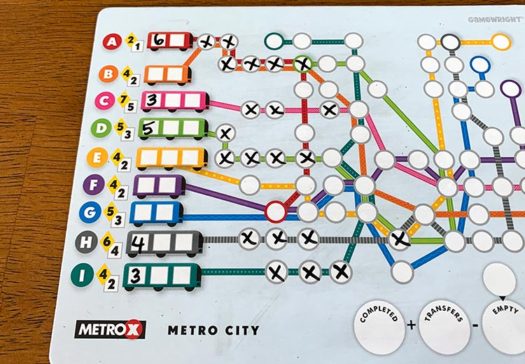
Since you don’t know the order in which the cards are going to be flipped, you can’t really plan ahead when you’re marking off stations. Oh, you can hope for certain cards to come out. But you may be left hoping much longer than you can realistically wait for.
Those Skip cards can come in very handy to get past crossroads for sure. But when they come out early in the game, they almost feel wasted.
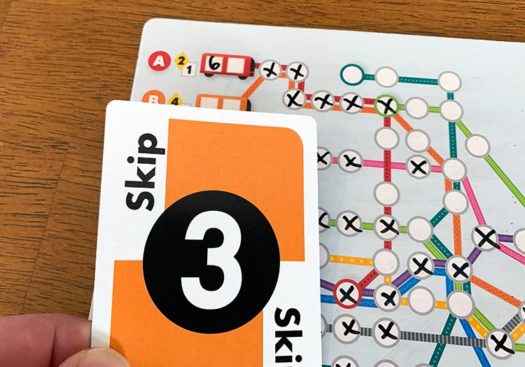
That being said, every time the Number card 6 is drawn, the whole deck gets reshuffled. So you may play games where that 6 keeps coming up before Skips are there to bail you out. Or the Free space card may not be drawn before the 6 comes up again and everything is reshuffled.
But of course, that’s what makes the game so engaging to play again and again. You just know the next time you play you’ll do better!
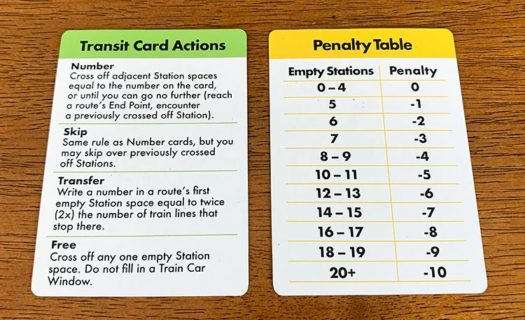
We also love that the game includes 6 boards!
That means even more people can join in the fun.
But it also means more people are competing to claim the routes first.
Since everyone is playing on their own board, it may feel like a solitaire game. There isn’t a way for anyone else to mess with your board.
And mom really loves that!
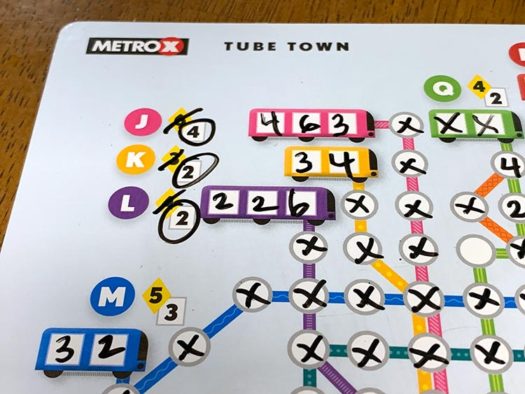
The only player interaction is that the first players to complete routes will claim the higher point value for those routes. So there is an incentive to complete routes first, but no one can block what you’re doing on your board. Everything that messes up routes on your board is your own fault!
The catch is that you’ll have to choose which routes you try to complete first. And for that matter, you’ll have to decide which routes you want to complete at all. Because you won’t be able to complete them all.
At least, we have yet to play a game where anyone completed every route. It would take just the right cards at every flip to work it out so that all routes could be completed.
But it’s fun trying!
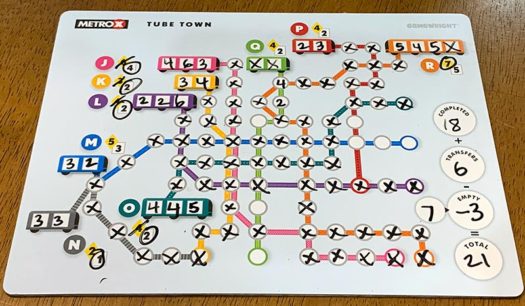
In fact, the rule book includes a section for Solo play and a chart with point ranges suggesting how you did. For example, if you score 50+ points it has “You are either a genius or have unspeakably good luck.” And if you only score 5 – 9 it’s “You need some practice.”
We’ll also mention that the Tube Town side of the board is a bit more challenging than the Metro City side. So if you’re up for more of a challenge in how to best navigate marking your board, play the Tube Town side.
Now, when are we going back to London to tackle the real Tube?
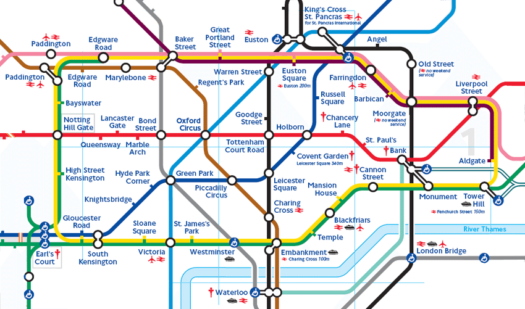
How does Metro X score on our “Let’s Play Again” game meter?
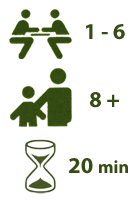 Metro X scores pretty high on our “let’s play again” game meter for 4 main reasons.
Metro X scores pretty high on our “let’s play again” game meter for 4 main reasons.
The first is how simple it is to pull out and play. It’s not full of complicated rules to remember or things we need to look up. We just open, shuffle, and play. And each game lasts only about 15 minutes.
The second is the tempting double-sided board. We have yet to play only 1 game of Metro X because as soon as we finish a game, we immediately flip the board over and play again using the other side.
The third is the simultaneous play. Because everyone is marking their board at the same time, there isn’t any downtime in the game. Sure sometimes we have to wait for a player to make up their mind in where to place their marks, but it isn’t very long before the next card is flipped and your marking again.
And the last reason is that it’s fun. With how the cards turn up randomly, every game we have to puzzle out a good solution differently. And because we can never complete every route like we’d hope, we’re anxious to try Metro X “just one more time”.
Fun stuff.
We’d like to thank Gamewright for a review copy of Metro X.



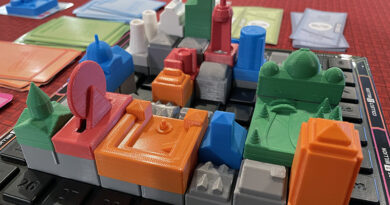
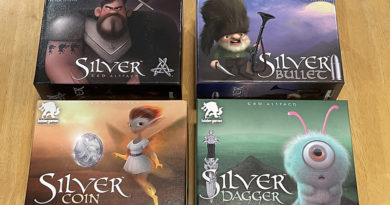

That is so neat that you have a personal experience relating to the theme of Metro X! That must make it really come alive for you guys. I do hope you are able to make it back to London again soon.
The game does sound very interesting. What are your thoughts on their use of cards rather than dice. It definitely is a unique rendition of the roll and write concept.
We like the cards for this one because of the distribution of the options. Rolling dice would bring a lot of randomness into it. Whereas with cards, you know what has already come out and better gauge probability of what’s next. And when a 6 is drawn, everything gets reshuffled and you can get your hopes up again for just the right cards.
Neat! What a clever way to add some strategy and planning ahead to keep the luck aspect in check.